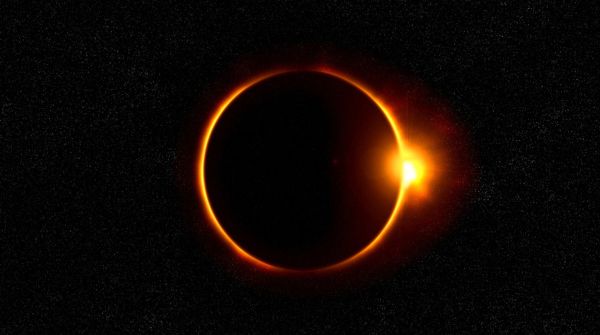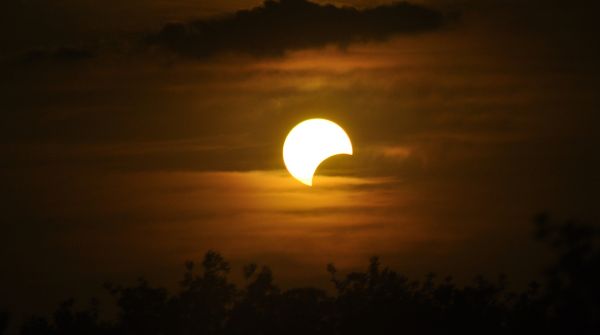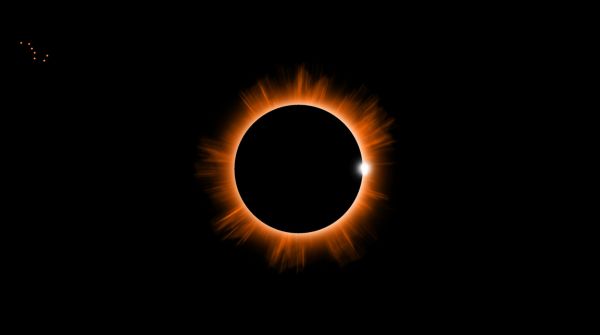Contents
According to the Panchang, 2024 will see two solar and two lunar eclipses. A solar eclipse occurs when the Moon blocks sunlight from reaching Earth by positioning itself between the Earth and the Sun. A lunar eclipse occurs when the Moon, Earth, and Sun align in a straight line, casting Earth’s shadow on the Moon. These celestial events are significant in Hinduism, prompting the prohibition of auspicious activities during an eclipse. Continue reading to learn more about Surya Grahan 2024.
| Meet SheSays Co-founder Trisha Shetty |
|---|
Surya Grahan 2024 Date & Time

Solar Eclipses are important in Hinduism, and the year 2024 will see four eclipses—two solar and two lunar. The first solar eclipse will be in April, specifically on the new moon day of Krishna Paksha in the Chaitra month. Unfortunately, this surya grahan will not be visible from India.
The Surya Grahan 2024 is scheduled for Monday, April 8, 2024, from 9:12 p.m. to 1:25 p.m. (Indian time), during the Amavasya Tithi. The unique alignment of the Moon, Earth, and Sun during these eclipses is considered spiritually significant, and in Hindu tradition, auspicious activities must prohibited during these times.
First Surya Grahan 2024 Places
An eclipse occurs when the Sun, Moon, and Earth align so that the Moon blocks sunlight from reaching Earth, casting a complete shadow on our planet and causing near darkness. This celestial event is known as a total solar eclipse. The upcoming 2024 solar eclipse will begin in the South Pacific Ocean and travel through North America, Mexico, and Canada.
Countries such as Costa Rica, Cuba, Dominica, French Polynesia, and Jamaica will expect to have partial visibility. However, due to the nighttime in India, it will not be visible. As a result, according to religious beliefs, the Sutak period, which begins 8-9 hours before the eclipse and ends when it occurs, will not apply in India.
| Best Museum Exhibits In Los Angeles |
|---|
Next Surya Grahan 2024 Date
The next Surya Grahan 2024 will be on Wednesday, October 2, and it will be the second eclipse of the year. This event will classify as an annular solar eclipse. What distinguishes it is the Moon’s relative distance from Earth, making it appear smaller than the Sun.
In this cosmic arrangement, the Moon only covers the central part of the Sun, creating a captivating effect—the Sun’s outer ring gleams like a fiery ring, earning it the nickname “Ring of Fire.” This display occurs during an annular solar eclipse, which promises a celestial spectacle in which the Sun appears bright and ring-like in the sky.
Things To Know During Surya Grahan 2024

The upcoming Surya Grahan 2024 on April 8 will not be visible in India, so the Sutak period will not apply. However, this celestial phenomenon will appear in the skies of East Asia, Australia, the Pacific and Atlantic Oceans, the North Pole, North America, South America, Southwest Europe, and the South Pole.
Traditional beliefs warn against going outside during a solar eclipse and strongly advise against staring directly at it with bare eyes. Pregnant women must stay indoors during the eclipse due to its perceived effect on pregnancy. Furthermore, activities like sewing, weaving, nail cutting, and touching temple idols are prohibited.
| Museum Exhibits in NYC |
|---|
Surya Grahan 2024 Effects
Drop in temperature:
Aside from the visual changes, the total solar eclipse alters the feel of the environment, resulting in a temperature drop. Similar to the cooling effect of twilight, the eclipse’s temporary dimming can result in a significant temperature drop. The temperature drop may not be as dramatic as in the 2017 summer eclipse, but the celestial alignment promises a noticeable change in atmospheric conditions.
Animal Behavior:
The sudden onset of darkness in the middle of the day can influence animal behavior with a unique glimpse into their intriguing reactions. A study conducted following the 2017 Great American Eclipse discovered that birds became confused during the change in sunlight. Chickens, for example, may misinterpret the eclipse for the start of the night, prompting behaviors such as seeking roosting sites or looking for food, which mimic their responses to dawn. The eclipse offers a unique opportunity to observe and study the fascinating reactions of various creatures to this celestial event.
Stars and Planets:
As the Moon covers the Sun, turning day into night, the celestial landscape unfolds, revealing stars and planets. While it is normal to see stars and planets at night, the eclipse offers a one-of-a-kind opportunity to spot Venus and Jupiter easily, which will be near the Sun on April 8.
360 Degree Sunrise and Sunset:
During the solar eclipse on April 8, observers will be captivated by the sky and the remarkable phenomenon visible from below. During totality, spectators will see a breathtaking 360-degree sunrise and sunset. This enchanting display is caused by sunlight filtering through areas outside the path of totality, creating a mesmerizing panorama of colors in all directions.
Eclipse Shadow ‘Snakes’:
Eclipse Shadow bands, also known as “shadow snakes,” are a rare and fascinating phenomenon to observe during a total solar eclipse. While not guaranteed at every eclipse, if they do appear, observers will be treated to a mesmerizing spectacle resembling snakes slithering across the ground.
| Museum Exhibits in Washington DC |
|---|

